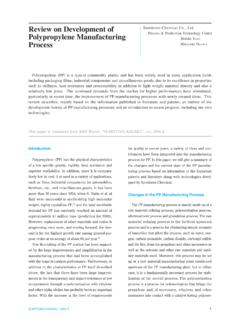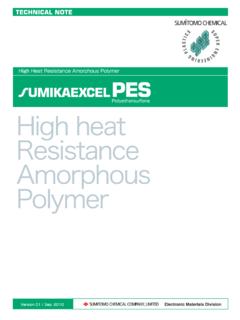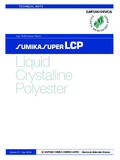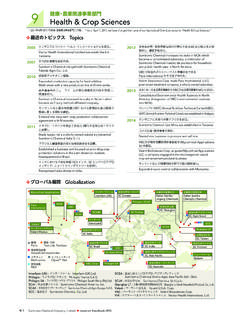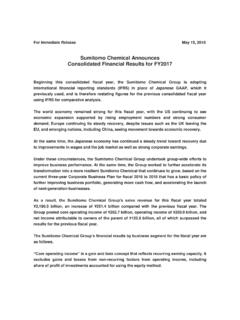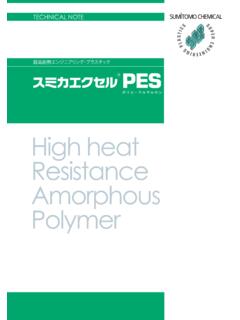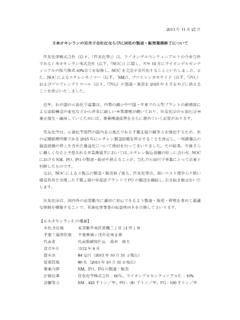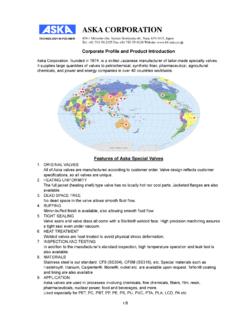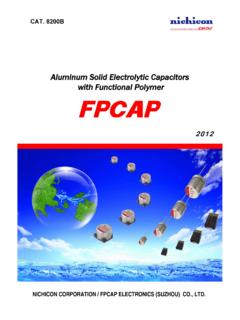Transcription of Polypropylene Compounds for Sumitomo Chemical …
1 1 Sumitomo KAGAKU 2010-IIntroductionBecause Polypropylene (PP) is low in cost but has out-standing mechanical properties and moldability, it ac-counts for more than half of all the plastic materials usedin automobiles. PP Compounds are used for a variety ofparts, including bumper facias, instrumental panels anddoor trims. Several grades of PP Compounds , with theirdiverse performance characteristics, have been devel-oped by compounding PP with various other materialsaccording to the performance requirements of the in-tended parts. As of 2007, million tons of PP (8% ofthe world s total PP consumption of million tons)and 690,000 tons of PP (approximately 23% of the totaldomestic PP consumption of million tons) are usedfor automotive )In recent years the envi-ronmental adaptability of PP has drawn significant atten-tion. Therefore, it is expected that PP consumption willcontinue to increase in the 1shows an example of a general constitution ofPP Compounds for automotive applications.
2 The impactstrength of the impact PP, which is composed of homoPP and ethylene propylene copolymer (EP copolymer),is improved by adding an ethylene-based elastomer suchas ethylene-butene or ethylene-octene copolymer, towhich inorganic filler such as talcum is added for en-hanced growth of PP Compounds for automotive applica-tions has thus far been supported by the improved per-formance of PP resins which serve as the base of PPcompounds and advancements in compound technol-ogy. With respect to the former, catalysts and the poly-merization process have been continually, energeticallyimproved in order to control the primary and higher- Polypropylene Compounds forAutomotive ApplicationsSumitomo Chemical Co., Ltd. Petrochemicals Research Laboratory Satoru MORITOMI Tsuyoshi WATANABE Susumu KANZAKIE ngineering plastics and metals have been extensively replaced by Polypropylene (PP) based materials in auto-motive parts in order to achieve weight reductions and cost savings.
3 To accomplish this, PP Compounds which aremade from PP and other components are under intense investigation. In this paper, we review the progress of re-search into compounding technology, improvement of mechanical properties and functionalization. Some problemsand solutions for injection molding are also summarized. Furthermore, material developments for environmentalload reduction are 1 Component of PP compound for automotive applicationFlowability, StiffnessImpact modifierReinforcement fillerBlock PP (Impact PP)EP Copolymer(EP part)Homo PP(P part)Additives(Colorant)Impact resistance, Mold shrinkage, paintability, Surface appearance (Flow mark, Weld line, Gloss)Stiffness, Mold shrinkageProcess stabilityWeatherabilityThis paper is translated from R&D Report, Sumitomo KAGAKU , vol. KAGAKU 2010-IPolypropylene Compounds for Automotive Applicationsorder structures of polymers. Regarding the latter, im-provements in the performance and dispersibility of elas-tomers, as well as the control of particle size, dispersionand interface of inorganic fillers, have been attempted upto the present , the catalyst currently used for industrialpurposes is the Mg-Ti type, otherwise known as theZiegler-Natta (ZN) catalyst.
4 Subsequent to the discoveryof ZN catalyst in 1953 (and 1954), the improvement ofits performance has been continuously attempted. In thecourse of such development the polymer activity, stere-oregularity and morphology of polymer particles havebeen improved, thus contributing greatly to the simpli-fication of the polymerization process as well as to theimprovement of PP performance (Fig. 2). Since the be-ginning, the development of PP catalyst has been con-ducted with focus on two areas: polymer activity andstereoregularity. The standards of these properties arebecoming extremely close to the ultimate. In recentyears catalyst developments have been conducted withincreased emphasis on control over molecular weight(distribution) and copolymerization PP manufacturing process, accompanied by im-provements in the performance of ZN catalyst, has tran-sitioned from the slurry polymerization method, whichcontains the residual catalyst removal process and theby-produced amorphous polymer removal process,through the bulk polymerization method, which utilizesliquefied propylene as a solvent, and then to the gasphase polymerization method, which doesn t use theamorphous polymer/residual catalyst removal transition has propelled the streamlining of the PPmanufacturing process while promoting energy , several unique process methods (such as aloop-type reactor method having two polymerizationzones)
5 Are being developed in order to expand the mo-lecular weight distribution and control the compositiondistribution of copolymers in an effort to achieve higherfunctionality and performance in )With respect to resin-based automotive parts, lowerweight is demanded for the sake of reduced environmen-tal burden and better design and higher moldability arealso required. In response to that demand, variousphases of PP Compounds for automotive applicationshave been improved. The improvements made thus farinclude greater rigidity, impact strength, fluidity andcrystallization. Such enhancements of PP compoundshave been achieved by compounding PP with additivessuch as elastomers and/or various inorganic fillers, aswell as through higher stereoregularity, fluidity andrubberization which have been achieved with the afore-mentioned improvements in catalysts and the manufac-turing process. Thanks to these improvements, a widerange of performance requirements in automotive parts,for which various engineering plastics were convention-ally used, can now be covered by PP Compounds alone(Fig.
6 3). As a result, PP-based material consumption inautomotive applications has continued to increase. Thedetails of the compound technology will be described inthe following TechnologyTwin-screw extruders are most commonly used for theproduction of PP Compounds for automotive is essential that the twin-screw extruder has high pro-Fig. 2 Development history of Ziegler-Natta catalyst and polymerization process for PP: Atactic-PP cont. (wt%) activity (kg-PP/g-Cat)1960197019801990 YearTiCl3 CatalystTi/Mg HybridCatalystSlurry processBulk processGas phase process105341310 Fig. 3 Mechanical properties of PP compounds11010002000400060008000 Flexural Modulus (MPa) Izod Impact Strength at 23deg. (kJ/m2)PCm-PPE/GFPA/GFm-PPEm-PPEABSB umper faciaInstrumental PanelPillarImpact PPPP compoundsPP Compounds (Long glass fiber)PAEngine Room3 Sumitomo KAGAKU 2010-IPolypropylene Compounds for Automotive Applicationsductivity as well as the ability to disperse the additivessuch as elastomers and fillers within PP and prevent thedegradation of the material during the manufacturingprocess.
7 In recent years, accompanied by increased ap-plications in light-weight vehicles, materials having highfluidity (which facilitates thin-wall molding) have beenin demand. Because this type of material has the lowmelt viscosity of PP, which is the main component, thedesign of the extruder s screws is important in order toadequately disperse the 1shows the history and development of twin-screw extruders. The productivity and performance oftwin-screw extruders can be characterized by the groovedepth, the rotational speed of the screws and the motor sperformance. It can be observed that the groove depth,rotation speed and torque have increased along with thegenerational previously described, talcum is added to PP com-pounds to give them more rigidity. The use of talcumhaving finer particles has become the mainstream, ac-companied by more demanding performance require-ments. Fig. 4depicts the effect of talcum particle size onthe discharge )When using talcum at a minute par-ticle size, the discharge rate significantly decreases atthe same screw rotational speed.
8 This is because whensupplying the granulator with talcum having a minuteparticle size, the air between the particles is also broughtinto the machine, which causes the backflow of air to-ward the upper stream of the screws and results in thedeterioration of material supply 1 History and development of extruderGenerationNm/cm2 Shaft torque ratio (Md/a3)rpmMaximum screw speedOuter/Inner screw diameter (Do/Di)Number of : Torque, a: Shaft and axle distanceTriple flightDouble flightDoDiDoDiTo address this issue, screws having the design shownin Fig. 5are used. In this design the screws maintain theresin in the semi-molten state in the primary mixing sec-tion, maintaining the space between the cylinder and theresin passing through the section, and then dischargethe air that was brought in along with the talcum througha vent port located on the extruder s downstream to the conventional extruder, which meltsresin entirely within the primary mixing section, thissystem can significantly improve the productivity of theextruder by allowing the air to escape toward the down-stream of the 5 Concept of screw pattern for high throughput compounding Conventional CompoundingImproved CompoundingVentilationAirRaw MaterialsRaw MaterialsAirSealed by fully molten resinAirSemi- molten resin: incompletely-filled Fig.
9 4 Effect of talcum diameter on maximum feed rateScrew speed (rpm)Ma xim um feed ra te (kg/h )Average diameter0100200300400500020040060010 m6 m4 Sumitomo KAGAKU 2010-IPolypropylene Compounds for Automotive ApplicationsImproving the Rigidity and Impact Strength ofPP CompoundsInorganic fillers are added in order to improve the per-formance of PP. Table 2shows the inorganic fillers usedfor property )Fig. 6shows the stiffeningeffects of calcium carbonate in a granular state, tabular-shaped talcum and needle-shaped glass fiber. Of all thesefillers, glass fiber which has the high rigidity and as-pect ratio shows the greatest stiffening effect, followedby the tabular-shaped talcum. Given the considerationsof cost, performance and processability, talcum and glassfiber are mostly used for PP Compounds for 7shows the effect of talcum particle size on theIzod impact strength. Fig. 8shows the effect of the tal-cum aspect ratio on the flexural modulus.
10 It can be ob-served that the Izod impact strength increases as thetalcum particle size decreases and that the rigidity im-proves as the talcum aspect ratio increases. Conse-quently, it can be expected that greater rigidity can beachieved by further decreasing the particle size of thefiller. For this reason a great deal of nanocomposite PP-based material development has been studies have been implemented in regardto PP-based nanocomposites using montmorillonite as afiller. By optimizing the organification treatment agentused to cleave between two layers of montmorillonite, orby optimizing the constitution of the modified PP usedto improve the dispersion of montmorillonite, PP com-pound with greater rigidity can be )However,virtually few PP-based nanocomposites have been put topractical use, because the melt viscosity increases as thearea of resin/filler interface increases, the organificationtreatment agent is required for nano-dispersion of thefiller, and the manufacturing process cost is , the technology to selectively disperse fillerto a specific phase has been developed.
